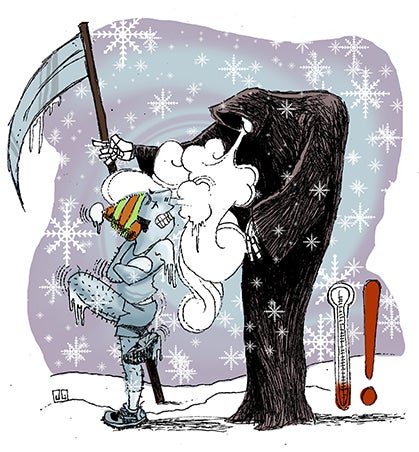How To Thwart Hypothermia's Dangerous Potential

Illustration by Jeremy Collins
Are you ready?” I ask my running partner, Mark. He hesitates. Standing at a trailhead in Great Smoky Mountains National Park, we decide not to let a little drizzle stop us, even though it is much more than a drizzle. Running a mountainous 15.5-mile loop would be tough, but on this soggy, 45-degree day, our overriding concern is hypothermia. Often referred to as the “silent killer,” it can have devastating effects on the ill-prepared.
Cold Confusion
Acute (or submersion) hypothermia occurs instantly (for example, falling through an ice-covered lake) but more often, runners need to be concerned about chronic or exhaustion hypothermia, which is an insidious lowering of the body’s internal core temperature several degrees below its normal 98.6 degrees.
The first symptom is loss of energy or slight disorientation, often referred to as a lowered level of consciousness. Since running burns up considerable energy, a sudden drop in running speed or mood can be difficult to recognize as the onset of hypothermia. Hypothermia-induced confusion makes you unaware that you are cold and need more clothing or your running pace has slowed.
Secondly, watch for shivering as a sign of decreasing body temperature. However, the absence of shivering can also indicate that the body no longer has the fuel to trigger the shiver reflex as a means to generate internal heat.
Once in a hypothermic state, your body shunts blood from the extremities to the core, thus leaving hands and feet susceptible to frostnip, indicated by reddening skin, or frostbite, in which the skin looks lifeless and turns pasty white or black.
Layer Up
Consider your clothing a system rather than individual clothing items. Next to your skin, wear a snug-fitting, moisture-wicking top that will move perspiration away from your body. Over this, add a windbreaker or lightweight waterproof-breathable jacket to block wind and rain and hold in body heat. Prevent overheating by unzipping and venting the various layers to allow extra body heat to escape. If the conditions are very cold, wear an insulating top made from hydrophobic materials such as fleece or wool.
Fuel the Fire
When running for an hour or more, carry high-carbohydrate foods like energy bars, dried fruits and nuts to stoke your internal furnace. Body heat is a by-product of the metabolism of food and is measured in kilocalories (kcal). Carbohydrates are easy to break down and convert into readily available muscle and brain energy, producing 4 kcal per gram of food.
Cold-weather running’s high-energy demands can also encourage your body to burn fat, a process that produces twice the energy of carbohydrates (a whopping 9.45 kcal/gram). Fat metabolism is a less efficient process, but the net energy gain still makes it the king of heat producers. Once carbohydrate stores are totally depleted, a starved body resorts to burning proteins, which are hard to metabolize. This produces about 4 kcal/gram but can lead to muscle damage.
Research at Natick Army Laboratories in Massachusetts found that even a 10-percent decrease in normal hydration levels could cause a 30- to 40-percent decrease in the body’s ability to regulate its internal temperature. In cold weather (and at high altitude), runners are especially susceptible to dehydration due to perspiration and rapid respiration. And since thirst lags behind true hydration needs, hypothermia can set in long before you realize you are dehydrated. Consume between 20 and 60 ounces of water per hour based on personal physiology and exertion level.
Help for the Hypothermic
RECOGNIZE. Check for the signs and symptoms of hypothermia such as change in level of consciousness and attitude.
LAYER UP. Replace any wet clothing and put any extra dry clothing layers on the victim.
HYDRATE. Feed a victim demonstrating early signs of hypothermia lots of warm fluids. Warm cold water by putting the bottles next to your body before giving it to the victim.
FUEL UP. Keep the victim warm and feed him easily digestible food.
WARM UP. If the victim is conscious, place bottles of warm liquids on the skin next to brachial and femoral arteries. Get him out of direct wind and sit him on a pack or other piece of equipment to insulate him from cold ground.
GET HELP. Go to a hospital as soon as possible-—the latter stages of hypothermia can be fatal. Avoid leaving a delirious victim alone as he may wander off and become lost. Rather, encourage him to walk with you to safety. If possible, send someone for help.
CARE FOR YOURSELF. In cold and/or wet conditions, monitor yourself so that you don’t also become a victim.
Stuart Cowles is a Certified Mountain Guide and Wilderness First Responder in Asheville, North Carolina. When he is not running trails in the Appalachia, Cowles can be found eating Snickers Bars and shivering in a tent on a cold mountain.